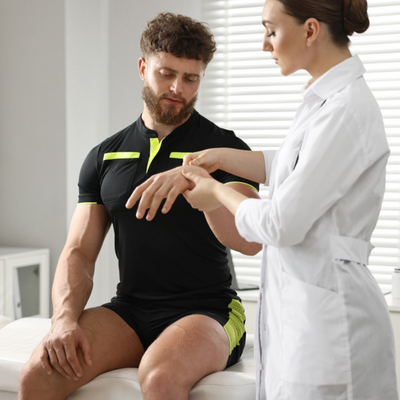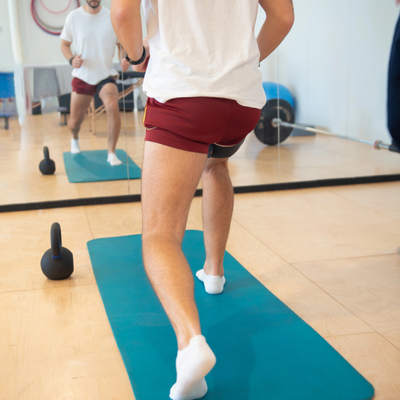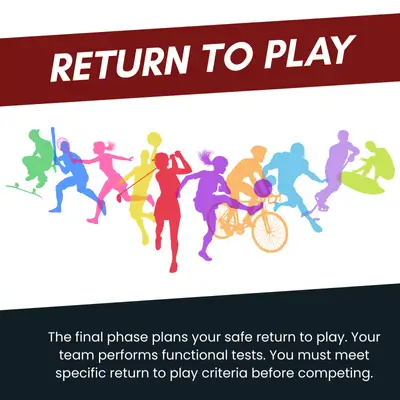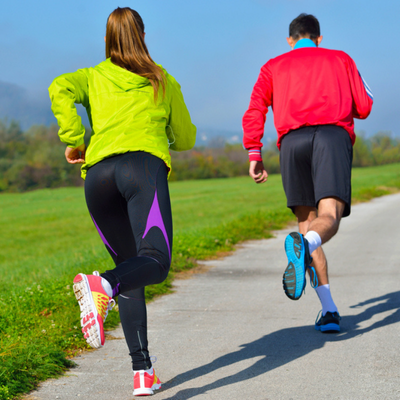Getting hurt in sports is tough. But athlete rehabilitation and physical therapy can get you back stronger than before with smart goal setting. This guide breaks down how sports physiotherapy builds a clear rehabilitation plan, explains how physical therapy works, and why it matters for every athlete.
What Is Athlete Rehabilitation?
Athlete rehabilitation helps injured athletes heal and return to their sport safely. Sports physiotherapy teams use proven treatment methods to restore function and build strength. This isn’t just about rest. It’s an active rehabilitation process that prepares your body for competition.
Sports physiotherapy focuses on sports injuries and athletic needs. The rehabilitation team includes sports physiotherapists, sports medicine doctors, and trainers. They work together to create your rehabilitation plan based on your specific rehabilitation needs.
The main goals are simple: reduce pain, restore mobility, rebuild strength and endurance, improve balance and coordination, and prevent future injury. A good sports rehabilitation program does more than heal. It often makes athletes stronger and less prone to injury through proper treatment.
The Sports Injury Rehabilitation Process
Every rehabilitation process follows key stages in physical therapy and sports physiotherapy. Your rehabilitation team guides you through each phase to ensure safe recovery and effective treatment.
Assessment and Treatment Planning

Sports injury rehabilitation starts with thorough injury assessment. Your sports physiotherapy team checks your range of motion, strength, and biomechanics. They look for muscle imbalances and joint problems during this crucial assessment.
Movement analysis helps identify what caused your injury. This evaluation shapes your entire treatment plan. Goal setting is crucial here. You’ll work with your rehabilitation team to set short-term and long-term targets through systematic goal setting.
Your rehabilitation plan is built around your specific needs. No two athletes get the same treatment. This personalized rehabilitation approach addresses your injury, sport, and individual goals.
Acute Phase: Protect and Heal
Early injury management focuses on protection and pain management. This doesn’t mean complete rest. Your sports physiotherapy team guides safe movement that promotes tissue healing through careful treatment.
Classic methods like rest, ice, compression, and elevation control swelling. Your rehabilitation team may use electrical therapy or ultrasound to reduce pain. The goal is protecting your injury while starting the recovery process.
Pool exercises or anti-gravity treadmills let you stay active without stress. This phase sets up everything that follows in your rehabilitation process through proper pain management techniques.
Restoring Mobility and Flexibility

Once pain drops, rehabilitation shifts to movement. Sports injuries often cause stiffness and limited motion. Your sports physiotherapy team uses stretching, manual therapy, and gentle exercises to restore flexibility and improve mobility.
Joint mobilizations and soft tissue massage help loosen tight areas. You’ll do mobility drills like wall slides and leg swings. Working on flexibility early prevents long-term problems and prepares you for strength training.
All exercises stay within pain-free limits. Good form matters more than intensity. By the end of this phase, your flexibility should be much better.
Building Strength and Endurance
With improved mobility comes strength training. Your rehabilitation program starts with bodyweight exercises and light resistance. The sports physiotherapy team targets both your injured area and surrounding muscles to build strength.
For knee injuries, you might do controlled squats and leg presses. Hamstring exercises support the joint and build strength. Endurance training builds stamina through longer exercise sets and improved endurance.
Your rehabilitation team watches your form closely. Poor technique signals it’s time to stop or modify intensity. Some teams use blood flow restriction therapy to build strength with lighter weights through specialized strength training.
Progress monitoring tracks your gains in strength and endurance. The rehabilitation team adjusts your program based on how you respond to treatment.
Coordination and Sport-Specific Training
Advanced rehabilitation focuses on coordination, agility, and sport-specific skills. Sports injuries disrupt your body’s position sense (proprioception). Special exercises restore these abilities and improve coordination.
Balance training, agility ladders, and reaction drills rebuild your coordination and balance. Single-leg balance exercises improve joint stability after ankle injuries. These skills prevent future injury through better proprioception.
Functional training mimics your sport’s movements. Soccer players practice cutting maneuvers with improved agility. Pitchers work on throwing mechanics. Sport-specific exercises refine movement patterns and build confidence.
This phase essentially reconditions your entire system. You regain coordination, speed, and movement patterns needed for competition through targeted rehabilitation exercises.
Return to Play

The final rehabilitation phase plans your safe return to play. Your sports medicine team performs functional tests to check strength, jumping, and agility. You must meet specific return to play criteria before competing.
Your rehabilitation team gradually reintroduces team practices and competitive scenarios. They emphasize injury prevention strategies you should continue. Proper warm-ups, mobility routines, and ongoing strength work address any remaining weaknesses.
Education is key during recovery. You learn to listen to your body and manage minor issues. A good return to play plan gets you back in action while minimizing re-injury risk.
Why Sports Physiotherapy Works
Sports physiotherapy succeeds because it’s comprehensive and personalized. Each athlete, injury, and sport is different. Sports physiotherapy teams design rehabilitation programs that fit your specific situation and recovery needs.
The rehabilitation approach addresses underlying issues too. Correcting biomechanics and fixing muscle imbalances helps prevent future problems. This method often improves sports performance beyond pre-injury levels through performance enhancement.
Goal setting keeps you motivated during tough times. Recovery can be mentally challenging. Clear, achievable targets give you control over the rehabilitation process. Your team celebrates progress and adjusts through ongoing goal setting.
Sports medicine integration ensures medical needs aren’t missed. Sports medicine doctors manage medications and make return decisions. This teamwork between sports physiotherapy and sports medicine creates comprehensive care and effective recovery interventions.
Long-Term Benefits and Injury Prevention

Good sports injury rehabilitation extends beyond healing through proper treatment. You learn proper warm-up routines and conditioning specific to rehabilitation sports. Your sports physiotherapy team identifies risk factors discovered during treatment.
If you had a hamstring strain, your recovery program included strengthening and flexibility work. Continuing these exercises as part of regular training helps prevent another injury through ongoing injury prevention strategies.
Improved proprioception and reaction time from your rehabilitation reduce falls and missteps. Correcting faulty movement patterns builds a more resilient body. Sports rehabilitation becomes injury prevention training through better balance and coordination.
Many athletes return with enhanced performance. The rehabilitation process addresses weaknesses and emphasizes optimal mechanics. You often come back with improved strength, flexibility, and technique through performance enhancement methods.
Advanced Rehabilitation Techniques
Modern sports physiotherapy uses cutting-edge rehabilitation techniques to speed recovery. Blood flow restriction therapy helps build strength with lighter weights. This method is perfect when full loading isn’t safe during recovery.
Your sports medicine team may use ultrasound, electrical stimulation, or other recovery interventions to enhance healing. These tools complement your exercise program and support the overall recovery program.
The sports therapy approach combines hands-on care and simple exercise plans in physical therapy and sports physiotherapy. This method treats your injury step by step, using targeted recovery options and specialized care.
The Path Forward
Athlete rehabilitation is an active, structured rehabilitation process led by sports physiotherapy experts. It combines targeted exercises, manual therapy, education, and psychological support. Following a proper rehabilitation plan achieves full recovery and often enhances performance.
Recovery requires patience, dedication, and expert guidance. Modern sports rehabilitation gives you a clear pathway: manage the injury, rebuild capacity, refine skills, and return with confidence through systematic goal setting and progress monitoring.
Don’t let an injury define your athletic future. Work with qualified sports physiotherapy professionals who understand your sport’s demands. Invest in quality sports injury rehabilitation and stick to your program. Turn your setback into a comeback that makes you stronger than ever.
Ready to start your recovery journey? Contact our sports physiotherapy clinic today to begin your personalized rehabilitation program. Your strongest performance is still ahead of you.

